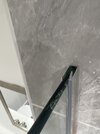I have just had a bath removed and full shower installed. The problem is that the sealant where I’m assuming the new drill holes were drilled for the screen are discolouring. Reddish/pink colour approx 1-2 inches in length, 3 areas inside and outside. I have taken the sealant out where visible on the outside but it’s changing colour again. I have shown the company but they’re aren’t fixing it.
Is this the tile dust which is then being drawn out by the moisture of the sealant and how do I resolve it?

Is this the tile dust which is then being drawn out by the moisture of the sealant and how do I resolve it?




